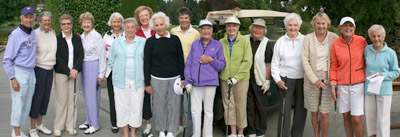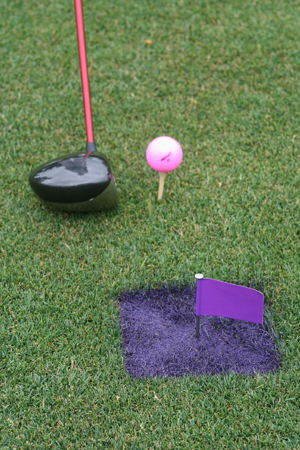home | internet service | web design | business directory | bulletin board | advertise | events calendar | contact | weather | cams

|
Tee it Forward  The 16 players who Initiated the Purple Tees' at Overlake.
Pat, in the middle with the purple jacket, hit the inaugural drive. The 16 players who Initiated the Purple Tees' at Overlake.
Pat, in the middle with the purple jacket, hit the inaugural drive.
On August 9th of 2011, 16 women ages 75 to 93 convened at Overlake Golf & Country Club in Bellevue, Wash., to initiate the new Purple Tees playing at 3,000 yards. Not a big deal on its own, but for Methow Valley resident Pat Thorlakson it was the culmination of three decades of crusading. Pat is 86 years old, once carried a 16 handicap and plays golf at least twice a week. Her handicap is now 40 and she's enjoying the game as never before. But it has been a struggle to get here. Over the years, as her age increased and prowess diminished, Pat began to realize that the forward tees at Overlake were too far back for her to have any hope of reaching greens in regulation. She was not alone, and for three decades the five-foot-tall dynamo lobbied for another set of tees farther forward. Her efforts were thwarted by a committee dominated by low-handicap, long-hitting women. "Everybody got upset with me because I had a one-track mind," she states. "When I started my campaign, there were very few who supported me." Her epiphany may have come about while playing a round with her late husband, Neil, a very good golfer. He hit a terrible tee shot but recovered with a fine 3-wood that ended pin-high and on the dance floor. She hit a good drive and 3-wood and was still 30 yards from the hole. She asked, in an article she wrote for Back Nine magazine in 1980, "Are (we) really playing the same game?"
In the same article and based on her experiences of failed attempts to have another set of markers, she noted that ". . . the strongest voices at each club are the low handicappers. They don't see any problem because the courses are built for their games." In 1993 at its annual "Clambake" in Myrtle Beach, some members of the Golf Writers Association of America initiated the idea that the appellation "Ladies Tees" be replaced by the designation, "Forward Tees," trying to erase the stigma of playing from those tees by weaker and elderly men. Two older GWAA members had a trial round and were delighted to again be hitting greens in regulation. It proved that not only women needed relief off the tee. It has taken time, but the big guns, the USGA, PGA of America and Golf Course Superintendents Association, have adopted club-maker Barney Adams' idea of most golfers moving up to a shorter tee. The initiative is called "Tee It Forward." In Golf Digest, scribe Jaime Diaz noted Adams' admonition that "The great majority of golfers should move up a tee and play courses from a shorter distance . . . And women should move way up. It's all in the interest of recapturing some of the fun that everyday golf has been losing, speeding up play and making the experience more attractive to core golfers, occasional players and beginners." So, the nationwide Tee It Forward campaign began. Tee placements are based on how far the golfer - of either gender - hits their drive, and notably separates PGA Tour players from the real world most of us hackers inhabit. Pat Thorlakson's efforts were well ahead of their time. Others may have had the same idea, but in all probability few had the persistence to endure three decades of denial. The results are shown in Overlake's scorecard, where purple tees are now at the front of the line as flat markers. From there, the course stretches 3,000 yards, the minimum length needed to carry a handicap. Not all golfers favor the Tee It Forward idea. Look it up on the Internet and read the debate. We won't quote any of the negatives because this piece is one of accomplishing a goal, and that of a little lady who could.
3/30/2012 Comments
|
 One of Overlake's purple tees.
One of Overlake's purple tees.